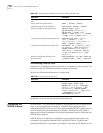
Configuring AAA 219
By default, after an ISP domain is created, the used RADIUS server group is the
default system (for relevant parameter configuration, refer to
“Configuring the
RADIUS Protocol ”), the state of domain is active, there is no limit to the amount
of supplicants, and the idle-cut is disabled.
Creating a Local User
A local user is a group of users set on NAS. The username is the unique identifier
of a user. A supplicant requesting network service may use local authentication
only if its corresponding local user has been added onto NAS.
Perform the following configurations in system view.
By default, there is no local user in the system.
Setting Attributes of a Local User
The attributes of a local user include its password, state, service type and other
settings.
Perform the following configurations in system view.
The auto parameter means that the password display mode will be the one
specified by the user at the time of configuring a password (see the
password
command in the following table for reference), and
cipher-force means that the
password display mode of all the accessing users must be in cipher text.
Perform the following configurations in local user view.
Set the idle idle-cut { disable | enable
minute flow }
Table 231 Create/Delete a Local User and Relevant Properties
Operation Command
Add local users local-user user-name
Delete all the local users undo local-user all
Delete a local user by specifying its type undo local-user { user-name | all
[ service-type { lan-access | ftp |
telnet |} ] }
Table 232 Set the Method that a Local User Uses to Set Password
Operation Command
Set the method that a local user uses to set
password
local-user password-display-mode
{ cipher-force | auto }
Cancel the method that the local user uses to
set password
undo local-user
password-display-mode
Table 233 Set/Remove the Attributes Concerned with a Specified User
Operation Command
Set a password for a specified user password { simple | cipher }
password
Table 230 Configure Relevant Attributes of ISP Domain
Operation Command


















